[Updated June 16, 2023] Probiotics are the future of sinusitis treatment. 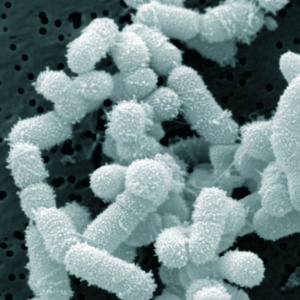 One probiotic (beneficial bacteria) that is lacking in those with chronic sinusitis and which successfully treats sinusitis is Lactobacillus sakei.
One probiotic (beneficial bacteria) that is lacking in those with chronic sinusitis and which successfully treats sinusitis is Lactobacillus sakei.
This page summarizes what has been learned over the past 10+ years: the best L. sakei products (such as kimchi and Lanto Sinus - which can treat even the worst recurring sinus infections, frequently within a few days), results of people trying various L. sakei products, and other possible probiotics for sinusitis and sinus health. It also discusses treatments that studies find don't improve sinus health (e.g., Lactococcus lactis, xylitol).
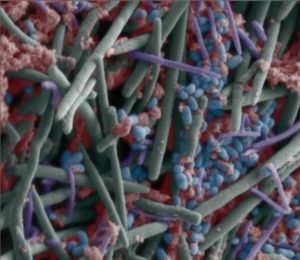 The sinus microbiome is the community of microbes (bacteria, viruses, fungi) that live in the sinuses. This community can become disrupted and imbalanced (dysbiosis) from illnesses, allergies, or antibiotics and cause a sinus infection or sinusitis. Research finds that not only do sinusitis sufferers lack L. sakei, they have too much of some other bacteria, and they also don't have the bacteria diversity in their sinuses that healthy people without sinusitis have.
The sinus microbiome is the community of microbes (bacteria, viruses, fungi) that live in the sinuses. This community can become disrupted and imbalanced (dysbiosis) from illnesses, allergies, or antibiotics and cause a sinus infection or sinusitis. Research finds that not only do sinusitis sufferers lack L. sakei, they have too much of some other bacteria, and they also don't have the bacteria diversity in their sinuses that healthy people without sinusitis have.
Back in 2012, a study by Abreu et al suggested Lactobacillus sakei as a possible treatment for sinusitis. In the past 10+ years those conclusions have been supported by the experiences of hundreds of people contacting me, and my family's experiences with L. sakei products. It really is the best sinusitis treatment for most people!
When Lactobacillus sakei works as a treatment - it can seem miraculous as sinusitis symptoms gradually disappear or greatly improve. Many times within a few days! Unfortunately it doesn't work for everyone - for a minority there seems to be no effect, perhaps because everyone's sinus microbiome (microbial community) is different. (See Treatment Summary page for different ways to use products.)
Another finding: only use L. sakei when needed. Not routinely and daily when feeling healthy. No boosters needed!
Luckily, Lactobacillus sakei is found in some foods (such as some brands of live fermented kimchi, and some sauerkraut), some sausage starter cultures (such as B-2), and recently in some probiotic supplements (e.g. Lanto Sinus). The food industry uses it because L. sakei dominates over and inhibits growth of pathogenic bacteria, including Staphylococcus aureus.
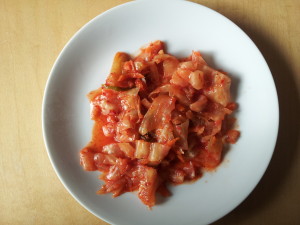 BACKGROUND STORY: Nine years ago there were no probiotics containing L. sakei, but studies reported it in some kimchi. So family members experimented using an easy kimchi sinusitis treatment (basically dabbing and smearing a little kimchi juice into the nostrils like a very messy eater) and found that it cured long-term chronic sinusitis within two weeks. Obviously this kimchi contained L. sakei. It felt miraculous!
BACKGROUND STORY: Nine years ago there were no probiotics containing L. sakei, but studies reported it in some kimchi. So family members experimented using an easy kimchi sinusitis treatment (basically dabbing and smearing a little kimchi juice into the nostrils like a very messy eater) and found that it cured long-term chronic sinusitis within two weeks. Obviously this kimchi contained L. sakei. It felt miraculous!
After 10+ years we still feel great! Because we no longer have chronic sinusitis and can easily treat sinusitis if it occurs with L. sakei, we have NOT taken antibiotics or any other bacteria killing spray or product (such as xylitol) for over 10 years.
WHEN A TREATMENT WORKS: People used terms such as "miraculous", "transformative", and "fabulous" when they had positive results.
When a treatment works, then all sinusitis symptoms go away, or there is major improvement - frequently within days. Symptoms that go away include post nasal drip, sinus headaches, "clogged ears", bad breath, and sinusitis-related coughs. Even tonsil stones! (Note: this is self-experimentation - effects can be positive or negative. Always be cautious.)
 OVERALL RESULTS: The majority of people reported positive results (chronic sinusitis improved or totally gone) from some form of L.sakei treatment. Since it's from self-experimentation and not a clinical trial, then I don't know the actual percentage of positive results.
OVERALL RESULTS: The majority of people reported positive results (chronic sinusitis improved or totally gone) from some form of L.sakei treatment. Since it's from self-experimentation and not a clinical trial, then I don't know the actual percentage of positive results.
Some of the people reporting success have had multiple operations, some have deviated septums, some with nasal polyps, and all have had long-standing chronic sinusitis, some for decades. Best results are to use only when needed.
The same treatments treat acute sinusitis or when sliding toward a sinus infection (perhaps only a few minor symptoms). After colds, etc. can develop acute sinusitis again and need re-treatment. But the sinuses do continue improving over time, so fewer and more minimal treatments are needed over time.
Another very small group reported that other probiotic strains helped, and a minority of people reported that nothing has helped. It also became clear that L. sakei does not treat seasonal allergies or allergy symptoms.
THREE MAIN PRODUCT CATEGORIES: Products containing live Lactobacillus sakei are: kimchi (and some sauerkraut), refrigerated products (e.g. Lanto Sinus), and frozen products. [Note: The FDA does not allow any probiotics to be sold as a medical treatment – they can only be sold as a dietary supplement.]
Using the following products to treat sinusitis is self-experimentation (results can vary). Always be cautious. (See Sinusitis Treatment Summary page for different treatment methods.)
 KIMCHI - Many people report that kimchi helped them. One person reported a homemade kimchi worked great (he was finally symptom free after 8 years). A few mentioned that kimchi has helped sinusitis with fungal problems.
KIMCHI - Many people report that kimchi helped them. One person reported a homemade kimchi worked great (he was finally symptom free after 8 years). A few mentioned that kimchi has helped sinusitis with fungal problems.
Some kimchi brands that people reported helping their chronic sinusitis: Sunja's Kimchi (mild white kimchi and medium spicy cucumber kimchi), Sinto Gourmet brand kimchi, Mama-O's Premium Kimchi, the white Napa kimchi and cabbage kimchi made by Choi's Kimchi Company (in Portland, Oregon), Farmhouse Culture Kimchi (in California), Ozuke Kimchi (in Colorado), in the United Kingdom the brand Mr Kimchi, and in Australia Kehoe's Kitchen white kimchi.
Not all kimchi brands or types of kimchi within brands contain L. sakei - finding one that has it is due to self-experimentation. The kimchi must be live, and not pasteurized. Some kimchi brands may contain L. sakei from about day 14 (or earlier) to about 2 to 2 1/2 months (from the day it's made).
When the kimchi contained L. sakei we felt the same or started feeling better within one or 2 days. If we felt more mucusy over the next 2 days, or the acute sinusitis kept getting worse, than it did not contain L. sakei. Some researchers feel that it's the garlic in kimchi that encourages L. sakei growth.
SAUERKRAUT - Sauerkraut has worked for some people if it is a sauerkraut made with garlic, such as some varieties of Cleveland Kraut. Some researchers feel that it's the garlic in kimchi that encourages L. sakei growth, and traditional sauerkraut typically doesn't contain garlic.
REFRIGERATED LACTOBACILLUS SAKEI PRODUCTS – A high-quality refrigerated L. sakei product specifically meant for the sinuses and treatment of sinusitis is sold by Lanto Health. The kimchi derived L. sakei product called Lanto Sinus is meant to be used when needed (when there are symptoms). Lanto Sinus holds up well in the refrigerator, is quick-acting, and easy to use. This product ships well.
People have reported success using it mixed with bottled water (dabbing, smearing, spooning a little in nostrils), or swishing it dry in the mouth. I’ve been a consultant with Lanto Health on this product and have been testing and using this product successfully for over 6 years when needed (self-experimentation!).
FROZEN LACTOBACILLUS SAKEI PRODUCTS – The main frozen L. sakei products available in many countries are frozen sausage starter cultures. All L.sakei products needing to be kept frozen are generally reliable and effective for sinusitis treatment. Only use when needed. Negatives with all frozen L.sakei products are that they must be kept frozen, they don’t hold up well once the package is opened, and they can easily die off during shipping.
Sausage starter cultures include BACTOFERM F-RM-52 (many countries, made by Chr. Hansen), PRIMAL SK NATUR 50 (Europe, made by Van Hees), and BITEC LS-25 (Europe, made by Frusarum). These contain 2 types of bacteria (L.sakei and Staphylococcus carnosus) – little is known about S. carnosus, but it is considered non-pathogenic, and no one has reported negative effects from it. B-2, which is only L. sakei (made by Chr Hansen), is available in New Zealand and some EU countries. The starter culture BACTOFERM SM 160 (L. sakei, Staphylococcus carnosus and Debaryomyces hansenii) has also been used successfully, but be very cautious (the third bacteria is considered non-pathogenic, is common in food products, is used commercially, but it is a yeast species - fungi).
Most use a frozen product by dabbing/smearing or spooning a little of the mixture (L. sakei and bottled water) into the nostrils, while a few others report using it in a neti pot. Sometimes a side effect on the day the product is used is a dry mouth and throat (and they can be very dry when overused - so only use a little).
See Sinusitis Treatment Summary page for ways people report using products.
SOME L.SAKEI ISSUES: It is killed off by antibiotics, by oxygen, and it only lives a limited amount of time at room temperature. [For ex.: the culture Bactoferm F-RM-52 package says it dies off in under 2 weeks at room temperature - therefore store in freezer.] On the other hand, Lactobacillus species live and multiply in our bodies at 98.6 degrees Fahrenheit, and studies find it lives in even warmer temperatures.
 Please note that the L. sakei in any product can also die off during shipping if it takes too long, it’s too hot (e.g. inside hot postal vehicles in extreme heat), or some other reason. Shorter shipping times are best in hot months. [Note: Consider overnight shipping during heat waves, especially when 100+ degrees Fahrenheit. USPS delivers to mailboxes, while UPS typically delivers to the door.]
Please note that the L. sakei in any product can also die off during shipping if it takes too long, it’s too hot (e.g. inside hot postal vehicles in extreme heat), or some other reason. Shorter shipping times are best in hot months. [Note: Consider overnight shipping during heat waves, especially when 100+ degrees Fahrenheit. USPS delivers to mailboxes, while UPS typically delivers to the door.]
WHY DOESN'T L. SAKEI WORK FOR SOME PEOPLE? Some possibilities why L. sakei products have not resulted in sinus improvement for some is that perhaps some other "keystone species" (a very important microbial species for a normal healthy community) is missing in their sinus microbiomes. Perhaps there are also nasal polyps. [Researchers think that those with nasal polyps have a "primary inflammation" problem.]
Even now much is unknown about ahealthy sinus microbiome,and so there are many unanswered questions.
PROBLEM WITH A PRODUCT SUDDENLY NOT WORKING, OR OVERUSE - 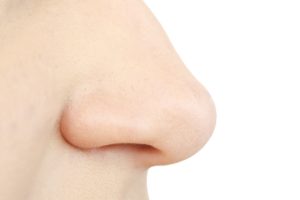 Some reported that a kimchi or L. sakei product that originally worked for them suddenly stopped working or not as well, but usually it had been the only product used for a while. There can be a feeling of "imbalance" or occasionally symptoms such as increased mucus, sore throat, post nasal drip, etc. This might be an issue of "too much" - and so you need to get some other beneficial microbes up there.
Some reported that a kimchi or L. sakei product that originally worked for them suddenly stopped working or not as well, but usually it had been the only product used for a while. There can be a feeling of "imbalance" or occasionally symptoms such as increased mucus, sore throat, post nasal drip, etc. This might be an issue of "too much" - and so you need to get some other beneficial microbes up there.
We found that immediately switching to another product (e.g., from one brand or type of kimchi to another), or from a L. sakei product to kimchi, or swishing multi-strain probiotics containing other Lactobacillus and Bifidobacterium species (the dry powder) in the mouth, or switching to refrigerated L.sakei in the mouth (if using kimchi before that) has corrected the situation for us.
We have even done this the same day when using another product - if we feel the need. (Finding what works is self-experimentation, and varies from time to time. May need to do this once or more times - as needed). And weeks later, we can use the original product once again. This is also why we only use a product when needed.
BOTTOM LINE: When feeling good, stop using the L. sakei product. Use L. sakei products sparingly - use only as needed (e.g. when developing symptoms). Using less is better – esp. as sinus microbial communities improve over time.
New research is finding that this advice - use only when needed - applies to all probiotics, and probiotic species. Whether for the gut or sinuses or whatever. [See post about daily use & gut health.]
OTHER PROBIOTICS AND PRODUCTS - Studies looking at other probiotic species have been generally disappointing. One well done study found that some sinusitis treatment products don't work, specifically the probiotic Lactococcus lactis (in Probiorinse), xylitol (Xlear) , and ordinary saline rinses. They don't improve sinusitis symptoms and don't improve the sinus microbiome. This is similar to what people have reported to me over the years.
Only rarely some people reported that multi- strain probiotics (the species varied, but they did not contain L. sakei) treated their sinusitis. They mixed the powder in the capsules with water and smeared or dabbed the mixture in the nose, or even used it in a saline rinse.
Avoid products with titanium dioxide – it may be in nanoparticle form, and recent studies have raised concerns that nanoparticles can travel to other organs in the body, and are inflammatory.
OTHER PROBIOTICS SOMETIMES HELP A LITTLE - Many people (including 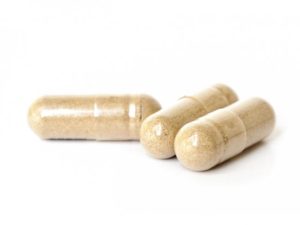 family members) reported trying various multi-strain probiotics containing various Lactobacillus and Bifidobacterium species in the nostrils and found they did not treat sinusitis. But if feeling a little “imbalanced” – perhaps a cough, post nasal drip, or mucusy – then swishing the dry powder from one capsule in the mouth and then swallowing it, can result in some improvement. [This is especially true if we suspect we have overused L. sakei.]
family members) reported trying various multi-strain probiotics containing various Lactobacillus and Bifidobacterium species in the nostrils and found they did not treat sinusitis. But if feeling a little “imbalanced” – perhaps a cough, post nasal drip, or mucusy – then swishing the dry powder from one capsule in the mouth and then swallowing it, can result in some improvement. [This is especially true if we suspect we have overused L. sakei.]
STILL UNKNOWN: Some multi-strain probiotics now contain L. sakei, but may be problematic if they don’t need refrigeration (e.g. Multi-strain Probiotic by Innovix Labs). L.sakei products typically die after a few weeks without refrigeration, and die when exposed to oxygen (anaerobic).
NO EVIDENCE FOR JUST SWALLOWING PROBIOTIC SUPPLEMENTS: Evidence 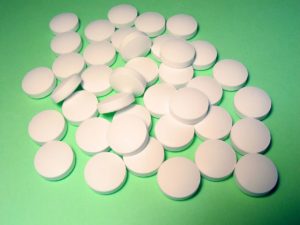 so far has been that only directly dabbing/smearing/spraying probiotics in the nose, or even swishing probiotics in the mouth may help treat sinusitis. No studies find that just swallowing a probiotic pill has helped sinusitis (including a 2009 study looking at swallowing L. rhamnosus tablets 2 times daily for 4 weeks).
so far has been that only directly dabbing/smearing/spraying probiotics in the nose, or even swishing probiotics in the mouth may help treat sinusitis. No studies find that just swallowing a probiotic pill has helped sinusitis (including a 2009 study looking at swallowing L. rhamnosus tablets 2 times daily for 4 weeks).
PROMISING PHAGE THERAPY - Some researchers in the USA and Australia are currently testing phage therapy to see if it could be used as a treatment for various conditions, including chronic sinusitis. A bacteriophage is a virus that infects bacteria, and the name literally means "bacteria eater". Phage therapy is the therapeutic use of bacteriophages to treat bacterial infections.
See post Phage Therapy May Help Sinusitis Sufferers for more information. The authors of one study said they found evidence for "virus-like particles" in sinuses, which they thought were bacteriophages.
SNOT TRANSPLANTS IN THE FUTURE? – Currently “snot transplant” studies from healthy persons to sinusitis sufferers are going on in Europe and Canada to see if it works as a sinusitis treatment. This may work great, but researchers have the same concerns as with fecal microbial transplants (stool transplant) for the gut. For example, are diseases also being transplanted?
PROBLEMS WITH BLIS K12 ? - Some people report that the probiotic BLIS K12 bacteria (also known as Streptococcus salivarius BLIS K12), can bring on sinusitis-type symptoms. Scientific research finds it to be an immune booster, good for oral health, etc. But for many: from the first tablet (slowly dissolving it in the mouth) there were problems - feeling mucusy, with yellow mucus.
Several persons reported similar negative effects with PRO-dental tablets, which also contains BLIS K12. The message here is clear: these specific bacteria did not react well with our sinus and oral bacterial communities. Remember, whenever one introduces new bacteria into the human organism, there can be positive or negative effects.
PLEASE WRITE! I would really like to hear how you are treating your sinusitis, especially chronic sinusitis. Or even what hasn't worked. Write to me privately, or can comment after any post.
Some other sinusitis posts to read:
Study Finds No Effect From Two Sinus Products (August 2022)
Ten Plus Years of Successfully Treating Sinus Infections With Probiotics (May 2023)
Microbes Live In Our Sinuses (May 2021)
Mold and Sinusitis (August 2020)

how soon can i start to use l sakei after sinus surgery and does flonase make l sakei inaffective
I advise discussing this with your doctor. It takes a long time to heal from surgery so during that time I definitely would not use kimchi (by dabbing in the nose) - kimchi has many different kinds of microbes in it.
Swishing L.sakei in the mouth (and then swallowing) is the most gentle way to test and use L. sakei.
Hello Sima, thank you for such an interestig blog and such indepth research. I'm completely fasinated.
I have enlarged nasal conchas and I'm wondering if any of your readers have commented on it helping?
I'm constantly congested and have trouble breathing through my nose... but this issue has only been persistent the last three years. I didn't have this problem BEFORE then.
I've been to two ENT's, one recommending surgery, one who was against surgery UNLESS absolutely necessary.
Perhaps it might be interesting to see if this would work for me.
I live in Denmark and unfortunately do not have access to kimchi - do you know of any probiotic strains that are being sold in Europe and are shelf stable that could be used?
Thank you!!
If the nasal stuffiness is due to sinusitis - then L. sakei generally helps. If it is due to allergies, then probably not.
I do not know of any products with shelf-stable L. sakei - that is, not needing refrigeration. It is generally only available as a frozen product or as a refrigerated product (e.g.Lanto Sinus). Most probiotics hold up better with refrigeration.
Hi,
Do you know if there is any other place than lantos where you can buy l sakei and that ships to South America?
Not sure if I will get a notification if you answer me here but if I don't could you send me an e-mail regarding the answer?
I do not know of any supplier that ships to South America. Perhaps the best possibility is looking for local suppliers of starter cultures for sausage making that contain L. sakei.
Hi
Another question, I know you mentioned that it won't help if the problems are due to allergies, but what about if you are not allergic but rather very sensitive to irritants such as pollen, air pollution, etc?
Will l. sakei help with that?
Lactobacillus sakei helps with sinusitis or other respiratory symptoms (mucus, congestion, coughs, etc.).
I personally used to become very congested and mucusy when exposed to air pollution, but once my sinusitis was treated (and they felt normal) years ago I found I could deal with air pollution much better (it no longer brought on nasal/sinus symptoms).
Only self-experimentation determines what L. sakei helps or doesn't.
Be very careful of phage technology. There is no longterm info on efficacy. I have a messed up micro biome, constant sinusitis right after chemotherapy. Pseudomonas and Klebsiella among others. I found your blog and was using Nasobiotex for several years to excellent effect. 13 years of constant pain under control and my lungs so much better (I ended up with COPD from the constant destructive barrage of Klebsiella and Pseudomonas.) But they changed their formula or contaminated it and I am now very sick. I also used LEF Florassist with Phage technology. Something you can perhaps never eradicate...
I recently had an eye infection, probably conjunctivitis, and my doctor prescribed an antibiotic ointment (erythromycin) to clear it up. It worked, but it also wiped out my sinus mictobiome, clearing the way for opportunistic bacteria to take hold. This resulted in a sinus infection that would not go away over several months. I tried using a garlic sauerkraut, since the hot peppers used in kimchi do not agree with me, and I figured it contains more garlic per ounce than most kimchis. It worked like a charm. I used the Cleveland Kraut brand. After two days, I felt better.
AND... for as long as I can remember, chopping onions and leeks would always (100% of the time) make me sneeze and cause my nose to run. (This is most unfortunate, since I volunteer in a soup kitchen.) But no longer! I was simply amazed. I chopped a whole pile of onions the other day with not even a trace of a sniffle. Clearly, something had been out of whack for a long, long time, and L. sakei helped to restore the balance.
So THANK YOU, Sima, for investigating and promoting this highly effective therapy!
Similarly, I found that people who have been on repeated courses of antibiotics can have problems with their eye microbiome once they stop antibiotics.
Good to hear about the sauerkraut.
Any thoughts on the use of L. sakei to treat or prevent cystic fibrosis-related infections?
An excellent question. Studies find that the lung and respiratory microbiome is different in those with cystic fibrosis. For example, reduced diversity and more potentially harmful species.
Only by trying L. sakei can one determine if it helps. And I would add that if it helps, to only use when needed.
How long would you expect that Mr Kimchi will continue to be effective if refrigerated? I have ordered two jars, one which I will use now and one which I plan to keep sealed in the fridge until the next time I need it. How long do you think it will last that way? Or would you recommend some other way? Thanks!
Keeping the second jar in the refrigerator unopened until you need it sounds like a good plan. Refrigeration slows down fermentation, but all kimchi goes through changes in microbes over the course of fermentation.
We found that with the brand we use (Sunja's kimchi) that L. sakei appears around week 2 from production and is in the jar (when unopened) for at least till the end of the second month, maybe longer.
Only trying it will determine if the L. sakei is still there.
Hi! What is the best way to figure out when the kimchi was manufactured, and how to ensure that I buy a jar that is between the two week and 2.5 month marker? Expiration dates won't do the trick, I guess? Thanks so much!
Can call the manufacturer, or can just try using the product (self-experimentation).
Also, if the expiration date is coming up soon, then assume it was made many months ago.
Assume that expiration dates are for at least 6 months in the future (e.g. Sunja's kimchi).
Can you swish l sakei and bot swallow it? Would that work?
Yes - swish and swallow is a good gentle way to use it. See Sinusitis Treatment Summary page for different ways to use it.
Do you have to swallow it for it to work?
Absolutely not. The bacteria travels through the respiratory system when swished in the mouth or smeared/spooned into nostrils.
The swallowing is just extra (if desired). Can always spit it out after swishing in mouth.
People normally get a little L. sakei from food and so studies find it in the gut (beneficial).
I tried L. sakei from Lanto Sinus, but unfortunately it made things worse. I swished it in my mouth and I had a headache the whole day and my nose became very congested. For what it's worth, they have fast shipping.
Several possibilities occur to me: L. sakei may not be needed in your sinus microbiome (perhaps there is enough in there already), or perhaps doesn't mix well with your sinus microbes (every person's sinus microbiome is different). Or perhaps it was a coincidence, especially since you mention using it only one day, and by swishing in mouth.
The big question is: After trying it and stopping, was there improvement from the baseline a few days later? (Improvements typically keep occurring for days after stopping.)
If you ever try it again, I would suggest trying a smaller amount, perhaps just a pinch. This is all self-experimentation.
By the way, we get L. sakei from many foods, and it is normally part of our gut microbes - in fact, it is associated with health and lower levels of inflammation.
Any more news/updates on phage therapy or "snot transplant"? Interesting stuff.
I have had problems with my sinuses/allergies most of my life. In the last 3 years, it has gotten worse in particular the right nasal. I've taken multiple allergy medications, multiple nasal sprays (steroid and antihistamine), had septoplasty and turbinate reduction. Allergy testing and changing things in our home to reduce exposure to allergens. Nothing has helped.
Nothing wrong structurally now - no deviated septum, didn't have polyps. I do have allergies, but I've went to pretty significant lengths to reduce that within our home. What I can not figure out is why is one side is far more problematic than the other and why is it getting worse now - what changed? It's not like any allergens I inhale only go in one side and not the other.
I was reading something a doctor wrote on another site (which is how I found your website actually) about a patient with chronic issues with one ear that self-treated by doing an ear wax transplant from his good ear to his bad one. Light bulb kinda came on - maybe only my right maxillary sinus's microbiome is out of balance?
So anyway, I'm currently waiting for my order of Lanto Sinus to arrive - should be here tomorrow. I am very interested in seeing what results I get. I had also been considering talking to my doctor about balloon sinuplasty and/or beginning allergy shots (immunotherapy) since the things I was most allergic to are not seasonal.
Haven't heard anything yet about those studies. I do know that much research came to a standstill this year due to COVID-19.
Yes, absolutely you can have problem only in some sinuses and not others. Research has actually found that the sinus microbiome can be different in each sinus.
I think it is normal that people have variation in which sinuses bother them (the most).
Good luck with the Lactobacillus sakei. Hope it works well for you. Self-experimentation!
Due to delays from I assume the holiday season / COVID-19, my package arrived several days later than estimated. It was picked up for shipping last Monday the 7th and delivered Tuesday the 15th. Do you think the product will still be effective?
I think it should be OK, especially because outside temperatures are cool or cold. Just refrigerate it now.
I do know that the strain used in Lanto Sinus can handle not being refrigerated for several weeks.
And remember: Lactobacillus sakei lives in our body at about 96 degrees.
You might consider that you have a decaying tooth, where a dental filling is causing the output/waste material of this decay to revers course and exit through the tip of the root, near your sinus! Look up Maxilliary sinusitis of endodontic origin for more information. I'm having a root canal soon on a tooth which is definitely dead/black and surely decaying, the tooth has never given me an abcess as such or pain, which is probably why it was never considered a factor by my EBT. However, upon investigation, there was a 'cloud like' appearence showing on the XRay around the root tip which might indicate inflammation caused by the aforementioned decay.
This is extremely interesting.
I have a grandson (2 yrs) who has recurrent ear infections (few rounds of antibiotics) and had tub placed in his ears. However, he still has ear infections..
I would like to know if you have heard of any people who has used L. Sakei and had improvement for ear infections.
Would greatly appreciate your comments.
Thanks
There is research showing that the ear microbiome (microbial community) is different in people with and without ear infections.
Yes, some people (adults and one teenager) reported that they used L. sakei to treat ear infections. Some ways that people tried it and thought it helped: 1) swishing the powder in the mouth, 2) dabbing kimchi juice in the ears, and 3) dabbing L. sakei mixed with water into the ear canal (but not too deep).
This is self-experimentation. One should always be cautious!
Hi Sima,
Donyou have any knowledge of how l Sakei might work for the sphenoid sinus. It seems like the hardest sinus to treat.
Thankyou
Our experience has been that L. sakei travels throughout the respiratory system and to all the sinuses - whether it's used in the nostrils (stronger) or swished in the mouth (gentler).
Hi,
Hope I’m not too late on this thread but I was just wondering. Have you received any success stories from nasal polyp sufferers?
Yes, some but not all. There are 2 things going on there - the polyps and the sinusitis. Nasal corticosteroids can shrink polyps, while L. sakei may help with the sinusitis (only trying it will determine if it works for you).
How do I get L. Sakei in Australia?
Can try kimchi (e.g., Kehoe's Kitchen white kimchi in Australia).
Or order sausage starter cultures (L. sakei) that are available in Australia.
Or can order Lanto Sinus.
You mention that BLIS K12 and PRO-dental tablets bring on sinusitis-like symptoms and conclude "The message here is clear: these specific bacteria did not react well with our sinus and oral bacterial communities".
Note that sinusitis-like symptoms like inflammation, sneezing, etc. are things that your immune system is doing, not things that an infection is doing. Immune system activation following probiotic administration doesn't necessarily mean this intervention was bad for you. If anything, I would bet that it's actually good for you.
Probiotics can kill off bad bacteria or similarly send them running. In either case, this could result in your immune system to recognize this "latent" infection and thus trigger these sinusitis-like symptoms. In my opinion, this better explains the observed symptoms than the immune system itself triggering on the probiotics. Regardless, though, I would caution against concluding that an immune reaction means an intervention was bad for you.
I don’t know if there’s any evidence for this because it’s rare, but I believe I have Thornwaldt’s cyst (crust type) which inhabits the midline of my nasopharyngeal area. Mucus and crusts form daily which fall off into the back of my throat. It can be distressing because there are times they make me gag. The treatment for this is either surgery or electrocauterization but like I said, it’s rare so I can’t help but wonder if something less invasive could solve the crusting. I’m going to try Kimchi and maybe this Lanto Sinus product just to see if anything changes.
Hmm...The symptoms sound similar to the postnasal discharge of sinusitis. Since there is a microbiome imbalance in sinusitis, bacteria such as L. sakei help. People report that L. sakei also gets rid of tonsil stones.
Hopefully it helps you also.
Anybody have a homemade recipe of kimchi that works
I don't have a recipe, but try to make kimchi with garlic (the L. sakei grows on the garlic). Likewise, can try making sauerkraut with garlic.
I tried the Kimchi rub into the nostrils 6 years ago to treat 3+ month long sinusitis and it seemed to help slightly but only for a few days I then ordered the L.Sakei from a sausage manufacturer and sampled it with water dilution into the nostrils but probably used far too much. I developed LPR, Laryngopharyngeal reflux days later. It was the worst condition of my life (49) and it lasted 8 months. I had globus sensation, difficulty swallowing and pain when swallowing. I couldn't eat much and quickly lost 20lbs in 8 months. I only realized it was the L.Sakei that caused the LPR months later because of the slight delay in the effects. BE CAREFUL. This was 6 years ago and because I did not remember the association between the L.Sakei and the LPR symptoms I recently stupidly tried the Kimchi in my nostrils again to treat sinusitis and I felt the globus sensation, throat dryness and sinus headaches but less severe just like I had 6 years earlier. Super bone headed I know. I would caution anyone to simply not take a "pro biotic" in the nose, perhaps eating it is ok. The possibility of getting these very troubling symptoms is real. LPR was the worst thing of my life. I could not enjoy coffee, food or even drinking water. Be careful
Whew..you went through a lot. I've never heard of such an association before, or even how that is possible. The NIH states that the condition is caused by: "..typically results from the effects of reflux on the glottis and vocal cords." In other words, gastric acid coming back up from the stomach.
That said, always, always be cautious when trying something new - we are all different and our microbiomes (gut, sinuses, respiratory, etc) are all different.
However, when a person feels that symptoms (e.g., post-nasal drip) are brought on by "too much" or "overuse" of a beneficial bacteria (probiotic), then adding other microbes to the respiratory system typically helps with symptoms. Open a multistrain probiotic (Lactobacillus and Bifidobacterium strains) and swish the powder in the mouth. Perhaps a few times. Effects from using probiotics for the sinuses are usually felt within a few hours.